Release Date : December 7, 2023
Developer(s) : Massive Entertainment
Publisher(s) : Ubisoft
Platforms : PS5, Xbox Series X/S, PC
After more than a year since the premiere of Avatar 2: The Way of Water, we’ve been eagerly awaiting the release of Avatar: Frontiers of Pandora, a game based on the Avatar film franchise. Initially scheduled for release in 2022, it was delayed until the end of the year, on December 7 for PC, PS5, and Xbox Series. Not to mention that this is the only second Avatar game to hit the gaming industry, following James Cameron’s Avatar: The Game in 2009, which didn’t make much of an impression.
But Avatar: Frontiers of Pandora will try to make up for that disappointment, and start with an advantage. The title is developed by Ubisoft Massive, best known for Tom Clancy’s The Division, which is truly excellent. So, what makes you so confident about this video game adaptation? You’ll find out why in the end, Avatar: Frontiers of Pandora could have done better, but the overall result is pleasant.
Pandora, the Sacred Land Sullied by the RDA

Without revealing too much about the storytelling, Avatar: Frontiers of Pandora’s plot is a bit of a mixed bag. The title begins with a few cutscenes before and after the battle on The Hallelujah Mountains, and then takes us directly to 2168, a year before James Cameron’s second film. We play the role of an unnamed Na’vi, descended from the Sarentu clan, which has been wiped out by the RDA but no one knows how.
So, after being cryogenically frozen for 15 years, your objective here is to find your origins, and to reacquaint yourself with the flora and fauna of Pandora along with your companions who escaped with you. Of course, not everything will be easy, as the RDA is stronger than ever, under the rule of Mercer. Basically, the game’s story is just as clumsy as Avatar 2: The Way of Water, if we are to compare it.
While we appreciate the fact that the lore has thickened considerably, with the introduction of new clans and their inspiring traditions, we have to admit that the pitch is pretty predictable. Some of the twists and turns can be seen a mile away, and although the stakes – saving Pandora from the clutches of the RDA – are high, and some of the shocking revelations are breathtaking, the predictability almost overwhelms everything.
However, returning to Pandora is pleasant, with a lore respected by Ubisoft Massive. The game is also in the same spirit as the first film, with the denouncement of colonization that James Cameron’s film dealt with effectively. Some of the sequences are also quite striking, with little nods to the characters from the films. At least that’s something. The character customization does exist, but unfortunately remains too basic, with limited modification possibilities when compared to other big productions.
Apart from the pitfalls of the storyline, which is easy to follow even though there are too many characters to introduce, the world of Pandora features some of the most fascinating art directions available. The various biomes we get to explore are magnificent and, above all, faithful. It’s a pleasure to see an Avatar game with endless forests and plains, combined with vibrant flora and fauna. Ubisoft Massive’s ability to bring the world of Pandora to life is certainly one aspect in which it has excelled.
Flexible and Dynamic Like a Na’vi, but With a Few Flaws

In terms of gameplay, Ubisoft Massive has opted for the FPS view, which pays off. In addition to being as immersive as the developers intended, our Na’Vi’s movements are pleasant. He’s much larger than a human, just like in the movies, and we get a direct sense of his speed and agility.
However, when it comes to the platforming aspect of the game, we’d have liked to see a little more animation, such as grabbing onto a ledge. We have the distinct impression that the software hasn’t been developed or refined in this area, especially as it suffers from annoying inaccuracies when it comes to climbing certain platforms.
Gunfights, on the other hand, are better, but still have room for improvement. While the overall feeling is almost as nervous and dynamic as Far Cry, the approach is completely different. You’ll have a total of seven weapons (slingshot, assault rifle, pump-action shotguns, short, long, and heavy bows, and rocket launchers that appear from time to time).
Stealth is more than a priority. Because playing tough won’t often be the solution, as your Na’Vi can die quickly due to its fragility. The only tools designed for infiltration are stun grenades. These will stun the RDA’s AMPs, and this is when you can use an execution (provided you’ve unlocked the skill).
Overall, it’s a good idea, even if the infiltration offered here is nowhere near Far Cry, where players had extra weapons to perform their stealth attacks. Here, apart from stun grenades, you can only punch basic humans, which feels a little cheap. As you can see, the stealth aspect of the game isn’t exploited to its full potential, and suffers from poor AI. It can sometimes fail to spot you when you’re close by, as well as seeing you from quite a distance. Calibration is poorly designed, although using Pandora’s scenery and flora and fauna can give you an edge over your opponent.
It seems that Ubisoft Massive is not used to developing this kind of gameplay. This is also evident in the use of assault rifles and shotguns, with their lack of precise aiming, making them a little too confusing and old-fashioned. In other words, the developers focused much more on the bow and spear than on firearms, even though your protagonist was trained and raised by the RDA.
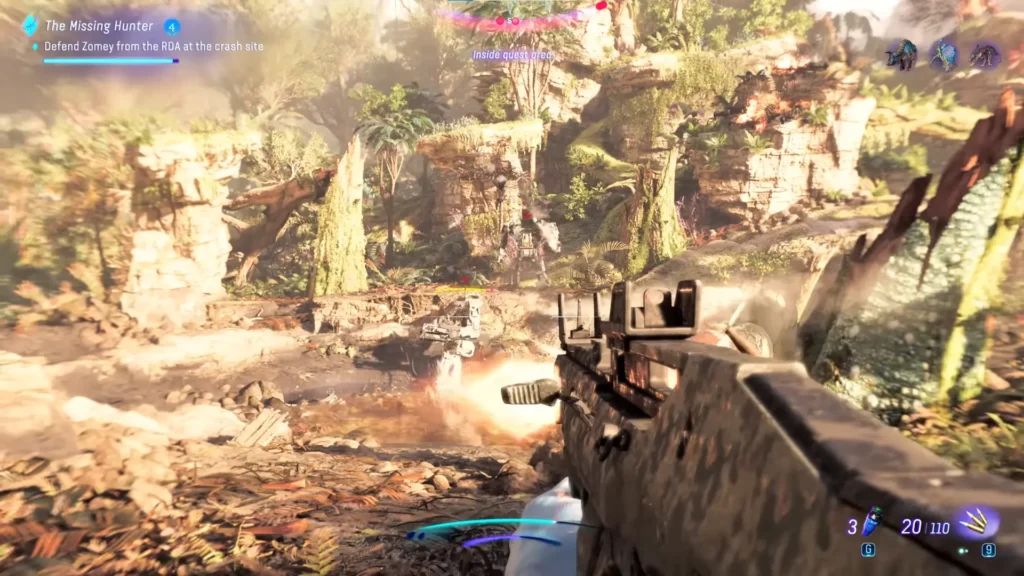
It’s also worth mentioning that the game’s difficulty is sometimes unfair. Indeed, it’s quite common to have a small power gap between your character and the quest, and your Na’Vi can easily be machine-gunned to death with just a few bullets. This balance is a little frustrating, and forces a little too much grind. So, yes, there’s some useful equipment you can pick up here and there during the main missions, but it’s not enough.
In addition to the RDA, Pandora’s environment is also a source of danger. You’re likely to take damage from toxic or explosive plants, as well as being attacked by local animals. This is a pleasant aspect of the game, and one that offers a variety of pleasures. Because, in absolute terms, Avatar: Frontiers of Pandora’s quests are certainly well-crafted, but the mission objectives are too repetitive, making you go to RDA outposts to destroy them or hack into various terminals to learn more about the corporation’s intentions, for example.
There are a few flashes of genius, with diversified quests where you have to link clues together or deactivate mechanisms via “pseudo puzzles”, but overall, the title could have done much better. The same goes for the clarity of progression, which is not always optimal when you find yourself looking for certain clues, or which direction to follow.
Your protagonist will have a fairly classic Na’Vi vision at his disposal. This allows you to see the many crates, plants, and objects with which you can interact, as well as mission objectives. It’s a generic feature that works, and note that you’ll be able to remove the slightest indication with its exploration mode, which allows you to visit Pandora at your convenience, without being bothered by the blue quest halo when using this vision. This will appeal to all types of players, although we didn’t find the guided mode all that invasive, especially if you don’t use the Na’Vi vision every five minutes.
Adopt an Ikran

Among the various gameplay features, flying an Ikran was highly anticipated, and it has to be said that handling our creature is very exhilarating. After completing a story quest, you’ll have the chance to customize and name your Ikran, using a basic editor. Once you’ve done that, the sensation of flying in TPS view is gripping. Moreover, it’s possible to upgrade it via a skill tree, giving it new moves that may come in handy if you’re up against the RDA.
It’s a gameplay idea that works, especially as it’s the fastest means of transport, alongside the fast travel that consumes your energy. Our creature will have a speed and energy gauge, similar to that of our protagonist. This second gauge is used to regain health. If it drops to zero, you won’t be able to get back on your feet, and you’ll have to feed your Ikran even in mid-flight, using hard-earned food.
Of course, the aerial battles are a success. Sure, the bestiary isn’t very diversified, with RDA helicopters and other flying monsters that you encounter rarely, but it has to be said that aerial combat offers something solid. Of course, there are a few inaccuracies, but it’s all very enjoyable. It’s also possible to connect with other mounts on the ground, but this is subject to a time limit, unlike our Ikran, with whom the connection is permanent. And let’s face it, jumping into the void and calling out to our winged beast to come and catch you is pretty cool.
However, your Ikran won’t immediately be able to follow you into any biome once it’s joined your cause. You’ll need to log in to specific areas via a story mode quest, in order to bring your companion into these new zones. Here again, it’s a small detail that has a small effect, and manages to immerse us a little more deeply into the world of Avatar: Frontiers of Pandora, transpiring fidelity to the cinematic license.
Hunting, Fishing and Harvesting, the Winning Combination

Hunting and fishing are aspects that Ubisoft Massive has clearly not neglected. To get the best out of your prey, you’ll need to be extremely careful, aiming for the right weak spot on each creature to get the most out of it. So it’s essential to use a bow or even a spear, rather than a firearm. Otherwise, the prize will be mediocre and you won’t get much out of it.
The care taken with the hunting aspect is impressive, as is the stalking of your prey. Using your Na’Vi vision, you can observe scent trails, making tracking much simpler and never frustrating. This makes it easy to track down creatures you want to hunt that have escaped, so you can eliminate them and harvest their meat or skins for crafting. Fishing isn’t too complicated either, but you’ll need good timing to get your sea trophy.
While hunting and fishing both offer something special and serve the purpose of crafting, so does the harvesting of materials. From fruit to moss, from specific branches to seaweed, there’s plenty to harvest on the lands of Pandora. In addition, the weather and the manner of harvesting will have an impact on its quality. And to collect most of the materials, you’ll have to perform a little QTE. This adds a welcome touch of immersion.
From Crafting to Cooking, One Step at a Time
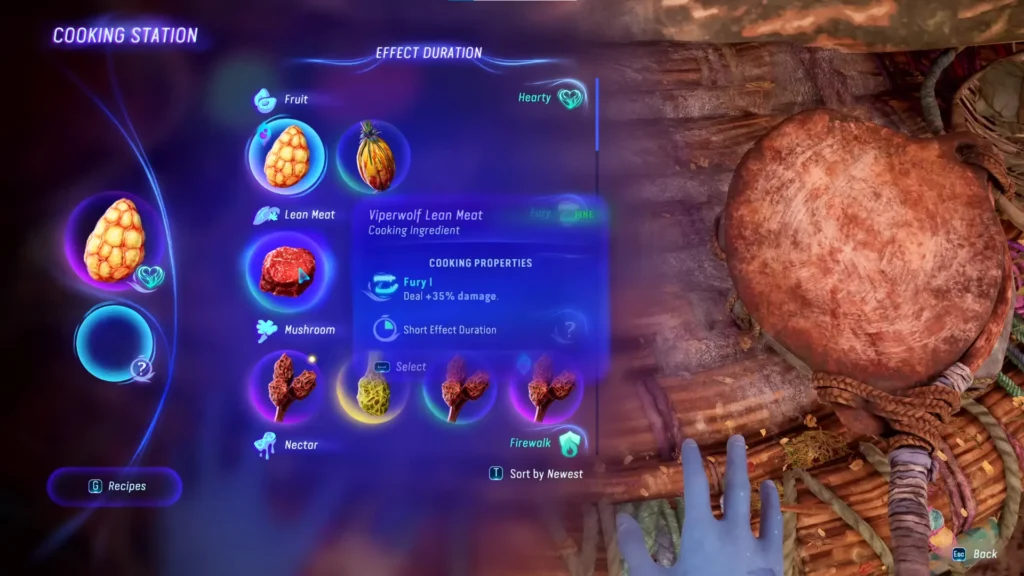
Most of the HQs you visit will give you access to many things, starting with the numerous merchants. In the Resistance HQ, they can sell you equipment, resources or weapons in exchange for RDA spare parts found in various crates, or even service charts. On the other hand, other clans will pay you in ” Clan Favor “. This means you’ll have to complete their quests, or deposit specific items in the community basket. At first, that’s a lot of currency to swallow, but you’ll eventually get the hang of it.
The workbench is also one of the central elements of the game. By acquiring plans from merchants, you’ll be able to craft new equipment or weapons. And it’s the quality of the resource that gives your weapon its damage levels, which may or may not raise your power level if you equip it. Basically, the system is pretty good, even if it’s frustrating that you can’t change the quality of the shot. It feels like Ubisoft Massive has just scratched the surface of this mechanic, which could have been something great.
At least, the cooking station has a very interesting feature. By combining two types of ingredient at a time, you can create recipes. And in addition to instantly regenerating your energy, like a classic RDA ration that you can find in outposts, these freshly prepared dishes will give you temporary bonuses. This adds a little extra edge to your tough encounters with the RDA or Pandora’s wildlife.
Pimp Your Na’vi
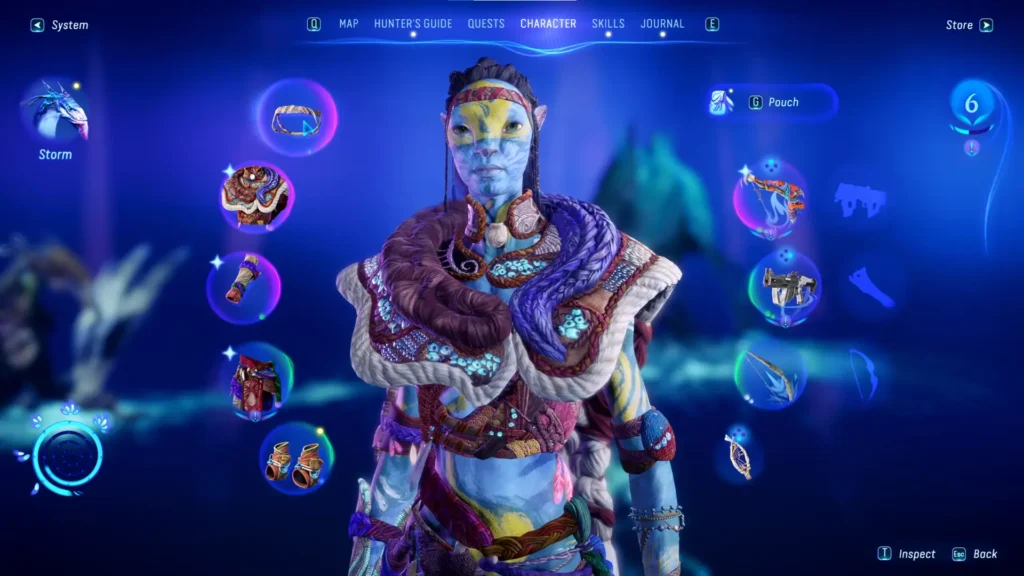
Customizing our hero is also an important element, with the assignment of equipment and guns. Like Tom Clancy’s: The Divsion 2, Avatar: Frontier of Pandora gives players the chance to customize their Na’vi from head to toe. Each time you equip an item or a weapon, you will increase your character’s power level. Overall, it’s very basic, and we may be surprised by the lack of indication of rewards at the end of a quest, or even when we raise our power level.
Unfortunately, there are quite a few errors in this aspect, although the skill system remains efficient. There are no less than five different skill trees at your disposal (survivor, warrior, hunter, maker and rider), as well as a special 6th. By completing quests or leveling up (again, very poorly indicated due to the regrettable absence of an experience gauge), you can earn skill points to assign to these five trees. This will allow you to earn new slots for your medicine bags, which complement your energy gauge, as well as recovering arrows from your enemies. Let’s be clear: skills don’t invent anything, even if they still work in practice.
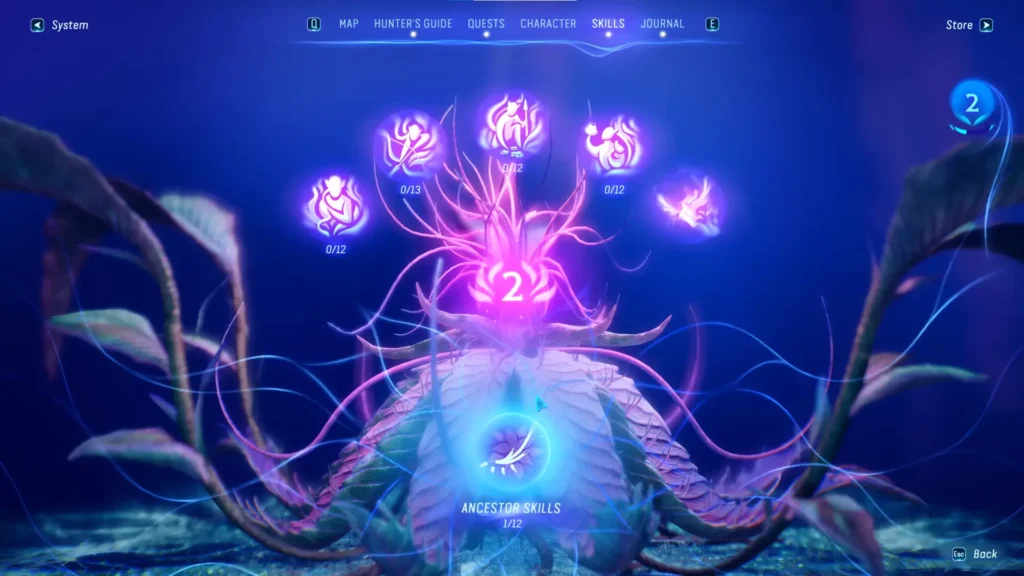
Finally, there’s the ancestor skill tree. This will only be filled by finding specific plants in Pandora’s various biomes. It’s through this that you’ll be able to unlock new skills, such as performing executions on the RDA’s AMPs. All this is a good idea, as it encourages exploration, which isn’t a bad thing after all.
Endless, Excessively Generic Activities
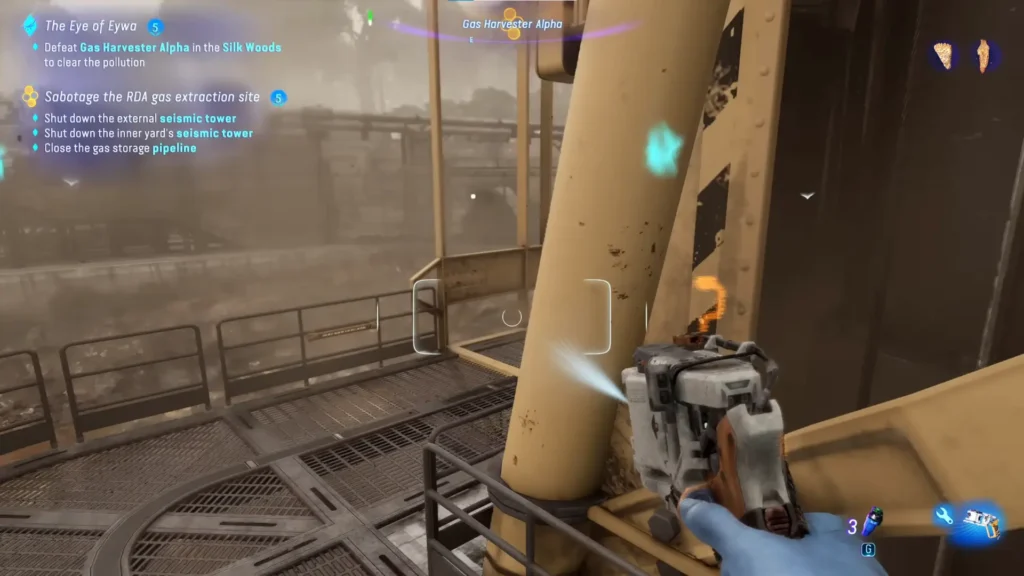
Apart from the game’s story quests, what else is there? Well, Avatar: Frontiers of Pandora is quite generous when it comes to additional content. Aside from the endless outposts, which become boring because of the obvious repetition of the assets used, there are plenty of other things to do. There are labs to power up by hacking them and completing a mini-game, small floating outposts to destroy, animals to pacify and remove RDA tracers, and clan side-quests.
What’s more, you’ll often meet other Na’Vi along the way. By talking to them, they can give you resources or even pre-prepared meals. In addition, you can find various Bellsprigs, which will give you max health boost, and even Tarsyu Saplings, which grant you an extra skill point by touching them.
In other words, the side activities are enormous, and the omnipresence of life on Pandora helps to keep us eager to explore every nook and cranny. As for the game’s lifespan, you’ll need almost 30 hours to complete it in a straight line. Overall, that’s a very good lifespan, and don’t forget that the endgame lets you continue to complete the remaining outposts and side quests. And let’s not forget that the title can be played in co-op, like Far Cry, where another person can join you to complete a few outposts together.
A Graphical and Sonic Ambience That Makes You Shiver, or Nearly So
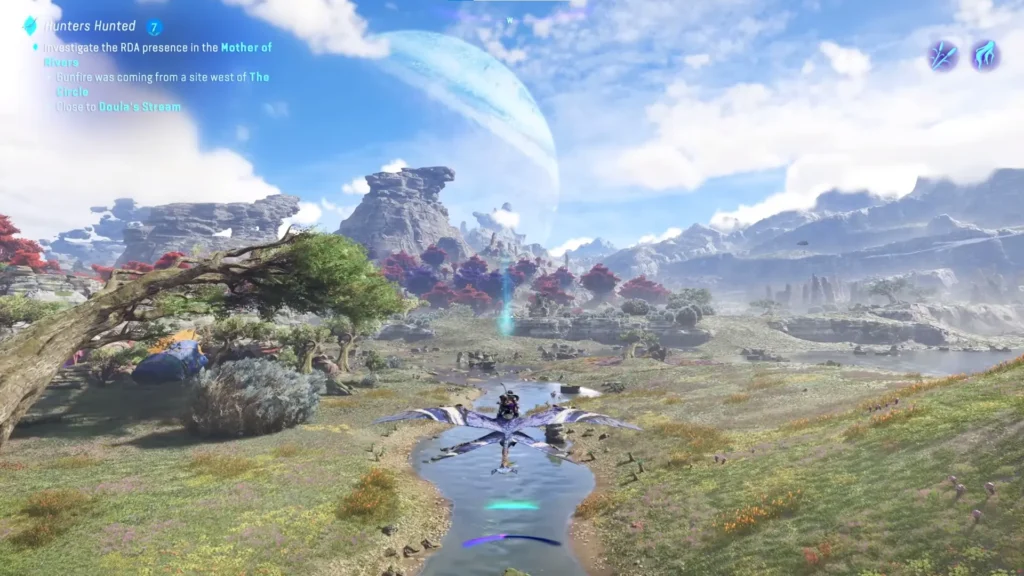
If you’re wondering, yes, Avatar: Frontier of Pandora looks great, at least on PC since we haven’t touched the console version. The various environments are stunning, and the attention to detail is evident at every turn. It’s quite common to marvel at some of the stunning backgrounds, and the level of detail of the 3D models is generally good.
Of course, as expected, the result is offset by uneven textures and a few bugs. While the optimization is good, we must highlight the fact that the game suffers from some clippings when we’re riding the Ikran, sometimes alarming display delays, as well as some glitches with enemies that don’t know what they’re doing. Or simply collision bugs. We’ve already had a 2GB patch during our test that didn’t correct this, and we’re hoping that another will emerge to erase these few errors that spoil the experience.
Finally, the sound design of Avatar: Frontiers of Pandora is sublime and almost flawless. with great soundtracks. They were composed by Pinar Toprak, the same person who composed the music for Captain Marvel. Well, it’s not a great example, but at least the soundtrack is faithful to the original, which is, admittedly, a pure delight for the ears, as it accurately conveys the universe of the films. But there are still some sound bugs to report. Once again, let’s wait for another patch to see if this problem will be definitively resolved.
Conclusion
Avatar: Frontiers of Pandora is a good game that fits in perfectly with the timeline of the films. Ubisoft Massive has succeeded in adapting Avatar’s majestic lore, while thickening it with new characters. The game is fairly beautiful, and the sound design is great. On the other hand, even if the gameplay is good overall, with a few flashes of genius and a certain speed, it falls flat on its face with a lack of precision and originality in the missions, and above all a narrative that is as clumsy as it is predictable. A lack of clarity is quickly felt in certain elements of game design, and the many ideas, good on paper, merely scratch the surface. However, this open world is vibrant, fluid, and offers a decent lifespan, along with several additional side activities with enough variety to invite players to visit the green lands of Pandora without reservation.